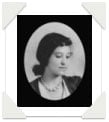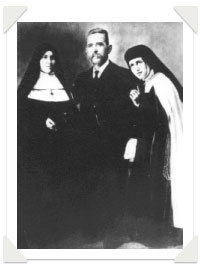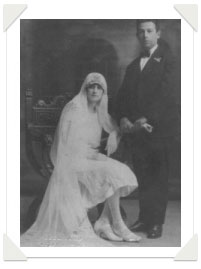Dear Reader,
I can still see my grandmother crocheting blankets in zigzag
rows. She made one for each of her seven children, many of her
twenty-three grandchildren (I am the eldest of the grandchildren),
and for the great–grandchildren she lived to see. My grandmother,
Esperanza Ortega, was the inspiration for my book Esperanza
Rising.
 |
| Esperanza Ortega Muñoz, approximately
19 years old. |
When I was a young girl, Grandma used to tell me what her life was
like when she first came to the United States from Mexico. I had
heard stories about the company farm camp where she lived and worked,
and the lifelong friends she made there. When she talked about those
people and how they had helped her through desperate, trying times,
she sometimes cried at the memories.
It wasn't until I had children of my own that my grandmother told
me about her life in Mexico, about a fairy-tale existence with servants,
wealth, and grandeur, which had preceded her life in the company
farm camp. I wrote down some of her recollections from her childhood.
How I wish I had written down more before she died because I could
never stop wondering about her transition from Mexico to California
and what it must have been like. Eventually, I started to imagine
a story based on the girl who might have been her.
 |
| Sixto Ortega with his two sisters,
nuns from a convent near Aguascalientes, Mexico. |
This fictional story parallels her life in some ways. She was born
and raised in Aguascalientes, Mexico. Her father was Sixto Ortega
and her mother, Ramona. They lived on El Rancho de la Trinidad (which
I changed to El Rancho de las Rosas) and her uncles did hold prominent
positions in the community. A series of circumstances, including
her father's death, eventually forced my grandmother to immigrate
to the United States to a company-owned farm labor camp in Arvin,
California. Unlike Esperanza in the story, my grandmother had already
married my grandfather, Jesus Muñoz, when she immigrated
to California. Like Miguel, he had been her father's mechanic. In
the segregated Mexican camp, with my grandfather, she lived much
like the characters in the story. She washed her clothes in communal
tubs, went to
jamaicas on Saturday nights, and cared for
her first three daughters. That's where my mother, Esperanza Muñoz,
was born.
During the early 1930's there were many strikes in the California
agricultural fields. Often, growers evicted the strikers from their
labor camps, forcing many to live together in makeshift refugee
camps, sometimes on farms on the outskirts of towns. The growers
were powerful and could sometimes influence local governments. In
Kern County, sheriffs arrested picketers for obstructing traffic,
even though the roads were deserted. In Kings County, one Mexican
man was arrested for speaking to a crowd in Spanish. Sometimes the
strikes failed, especially in areas that were flooded with people
from states like Oklahoma who were desperate for work at any wage.
In other instances, the strong voices of many people changed some
of the pitiful conditions.
 |
| Esperanza Ortega Muņoz (age 16) and Jesus Muņoz on their wedding day. |
The Mexican Repatriation was very real and an often overlooked
part of our history. In March of 1929, the federal government
passed the Deportation Act that gave counties the power to send
great numbers of Mexicans back to Mexico. Government officials
thought this would solve the unemployment associated with the
Great Depression (it didn't). County officials in Los Angeles,
California, organized "deportation trains" and the Immigration
Bureau made "sweeps" in the San Fernando Valley and
Los Angeles, arresting anyone who looked Mexican, regardless of
whether or not they were citizens or in the United States legally.
Many of those sent to Mexico were native-born United States citizens
and had never been to Mexico. The numbers of Mexicans deported
during this so-called "voluntary repatriation" was greater
than the Native American removals of the nineteenth century and
greater than the Japanese-American relocations during World War
II. It was the largest involuntary migration in the United States
up to that time. Between 1929 and 1935 at least 450,000 Mexicans
and Mexican Americans were sent back to Mexico. Some historians
think the numbers were closer to a million.
Even though my grandmother lived in this country for over fifty
years, I can still remember her breaking out in nervous perspiration
and trembling as her passport was checked at the border when we
returned to the United States from a shopping trip in Tijuana.
She always carried the fear that she could be sent back on a whim,
even though repatriation had long been over.
My father, Don Bell, came to California during the Dust Bowl from
the Midwest and, ironically, worked for the same company farm
where my mother was born. By that time, my grandmother had moved
her family to a small house in Bakersfield at 1030 P Street. Mom
and Dad weren't destined to meet quite yet. Dad was 12 years old
when he picked potatoes during World War II with the "Diaper
Crew," children paid to pick the fields because of the great
shortage of workers due to the war. He says the children weren't
always the most diligent employees and admits he more often threw
dirt clods at his friends than he picked potatoes. Later, when
he was 16, he spent a summer working for the same farm, driving
trucks back and forth from the fields and delivering workers.
Much of our nation's produce comes from this one area in California.
It is hot in the summer and cold in the winter. There are dust
storms and "tule fog" and some people do contract Valley
Fever. Before I got married, I took the required blood test in
San Diego, where I had lived during my college years. The doctor
called because of an "urgent finding" on my lab results.
I worried that something dramatic had been found, until the doctor
said, "You tested positive for Valley Fever."
I let out a sigh of relief. I grew up seeing lugs of grapes on
kitchen tables. I picked plums, peaches, apricots, nectarines,
persimmons, almonds, walnuts, and pecans from backyard trees.
Every year in August, I saw the grapes laid down on the ground
to make raisins the same way they've been made for generations.
Lemons, tomatoes, or squash appeared on our doorstep from neighbors'
or my grandmothers' gardens. I'd never been conscious of having
any symptoms of Valley Fever. The only fever I recollected was
my burning affection for my beginnings and belongings.
"Of course I tested positive," I said to the doctor.
"I grew up in the San Joaquin Valley." I knew that I
had been naturally immunized to the actual disease by merely living
there, from the air I had breathed growing up.
My family's feelings for the company camp are deep-rooted and
still filled with loyalty for their start in this country and
for the jobs they had at a time when so many had none. Most of
the people I interviewed who lived in the same camp with my grandmother
held no grudges against the Oklahomans or others who competed
for their jobs at that time. One man I interviewed said, "We
were all so poor. The Okies, the Filipinos, they were poor, too.
We all knew the feeling of wanting to work and feed our families.
That was why it was so hard for so many of us to strike."
When I asked about prejudice I was told, "Sure there was
prejudice, horrible prejudice, but that's how things were then."
Many struggled just to put food on the table and sometimes seemed
to be resigned to the social issues of the time. They focused
only on survival and put their hopes and dreams into their children's
and grandchildren's futures.
That's what my grandma did. She survived. All of her children
learned English and so did she. Some of her children went to college.
One became a professional athlete, another a member of the United
States Foreign Services others became secretaries, a writer, an
accountant. And her grandchildren: newscasters, social workers,
florists, teachers, film editors, lawyers, small business owners,
and another writer: me.
Our accomplishments were her accomplishments. She wished the
best for all of us and rarely looked back on the difficulties
of her own life.
It is no wonder that in Spanish, esperanza means "hope."

